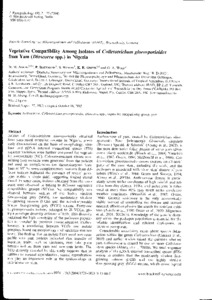| dc.contributor.author | Abang, Mathew M. |
| dc.contributor.author | Hoffmann, P. |
| dc.contributor.author | Winter, S. |
| dc.contributor.author | Green, K.R. |
| dc.contributor.author | Wolf, G.A. |
| dc.date.accessioned | 2019-12-04T11:23:48Z |
| dc.date.available | 2019-12-04T11:23:48Z |
| dc.date.issued | 2004-01 |
| dc.identifier.citation | Abang, M.M., Hoffmann, P., Winter, S., Green, K.R. & Wolf, G.A. (2004). Vegetative compatibility among isolates of Colletotrichum gloeosporioides from yam (Dioscorea spp.) in Nigeria. Journal of Phytopathology, 152(1), 21-27. |
| dc.identifier.issn | 0931-1785 |
| dc.identifier.uri | https://hdl.handle.net/20.500.12478/4164 |
| dc.description.abstract | Isolates of Colletotrichum gloeosporioides obtained from yam-based cropping systems in Nigeria, previously characterized on the basis of morphology, virulence and rDNA internal transcribed spacer (ITS) sequence variation were further compared for vegetative compatibility (VC). Chlorate-resistant nitrate non-utilizing (nit) mutants were generated from the isolates and used in complementation (heterokaryon) tests. Tests of VC between complementary mutants from different isolates indicated the presence of several genotypes within a single field, suggesting limited clonal spread. In some cases, isolates obtained from the same lesion were observed to belong to different vegetative compatibility groups (VCGs). No compatibility was observed between isolates of the highly virulent slow-growing grey (SGG), the moderately virulent fast-growing salmon (FGS) and the avirulent/weakly virulent fast-growing grey (FGG) strains. Forty-one C. gloeosporioides isolates belonged to 28 VCGs, giving a genotype diversity estimate of 0.68. This diversity confirmed the high variability of the pathogen population as revealed by previous characterization studies, however, a correlation between VCGs and isolate groupings based on morphology and virulence was not found. The finding that an isolate from weed was compatible with yam isolates indicated that transfer of important traits, such as virulence, may take place between isolates from yam and non-yam hosts. The VCG diversity revealed by this study suggests that in addition to asexual reproduction, sexual reproduction may play an important role in the epidemiology of anthracnose on yam. |
| dc.description.sponsorship | German Academic Exchange Service |
| dc.language.iso | en |
| dc.subject | Anthracnosis |
| dc.subject | Dioscorea |
| dc.subject | Yams |
| dc.title | Vegetative compatibility among isolates of Colletotrichum gloeosporioides from yam (Dioscorea spp.) in Nigeria |
| dc.type | Journal Article |
| dc.type | Journal Article |
| dc.description.version | Peer Review |
| cg.contributor.crp | Roots, Tubers and Bananas |
| cg.contributor.affiliation | Deutsche Sammlung von Mikroorganismen und Zellkulturen |
| cg.contributor.affiliation | International Institute of Tropical Agriculture |
| cg.coverage.region | Africa |
| cg.coverage.region | West Africa |
| cg.coverage.country | Nigeria |
| cg.isijournal | ISI Journal |
| cg.authorship.types | CGIAR and advanced research institute |
| cg.iitasubject | Yam |
| cg.accessibilitystatus | Limited Access |
| local.dspaceid | 99730 |
| cg.identifier.doi | https://doi.org/10.1046/j.1439-0434.2003.00795.x |

